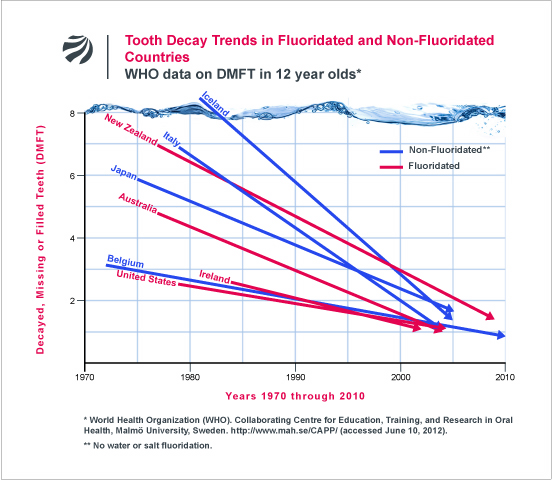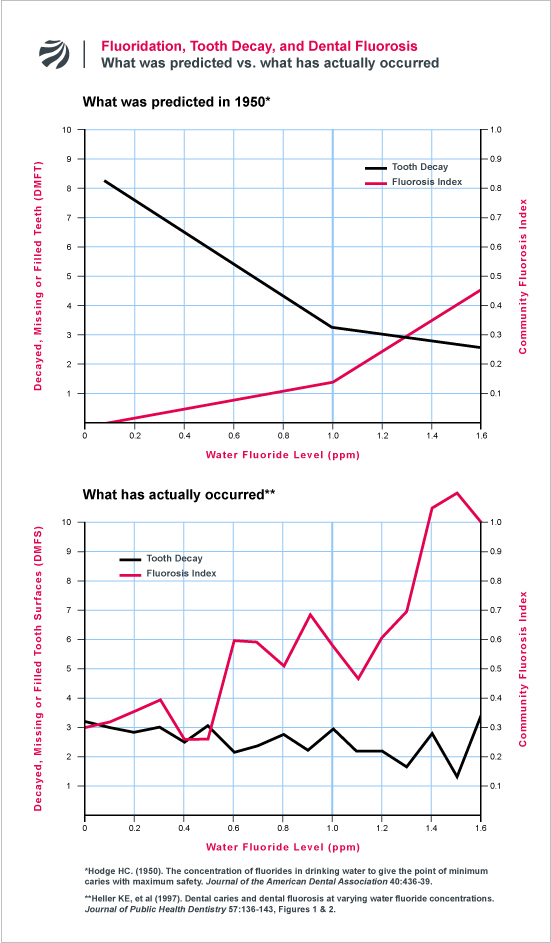Fact 1: Fluoride’s Primary Effect is Topical, Not Systemic
Water fluoridation began in the 1940s under the premise that swallowing fluoride is the most effective way to strengthen teeth. It is now known, however, that fluoride’s main benefit comes from topical contact with teeth, not from ingestion. Even if fluoridated water has a benefit, therefore, there is no need to swallow it.
Fact #2: There Is No Difference in Tooth Decay Between Fluoridated and Non-Fluoridated Countries.
In the United States, the Centers for Disease Control has called water fluoridation one of the “top 10 public health achievements of the twentieth century.” Yet, according to comprehensive data compiled by the World Health Organization, there is no discernible difference between the few western countries that fluoridate their water, and the majority that do not. WHO’s data also shows that, over the past 40 years, non-fluoridated countries have experienced the same (and ofter greater) declines in tooth decay as fluoridated countries.
Fact 3: Fluoridation’s “Benefits” Have Never Been proved by a “Randomized Controlled Trial”
A number of studies have purported to demonstrate very large benefits from drinking fluoridated water. In 2000, these studies were critically reviewed by an expert committee commissioned by the UK government (the “York Review”) and found to be of extremely poor quality. Few of the studies had controlled for factors that can greatly affect tooth decay (e.g., poverty), and no study had ever employed a “randomized controlled trial” method — the gold standard in medical research and required before most drugs can enter the market.
Fact 4: Modern Studies show fluoridated water does not reduce the number of decayed, Missing or Filled teeth
In the early days of water fluoridation, researchers studied its effectiveness at reducing tooth decay by using the “DMFT” index (“Decayed, Missing, or Filled Teeth”). Although early researchers stated that fluoridation reduced DMFT by over 60% (Hodge 1950), modern, large scale studies have repeatedly failed to detect any significant difference in DMFT between fluoridated and non-fluoridated communities.
One of the first studies to demonstrate this was a 1986-87 national study of oral health by the National Institute of Dental Research (NIDR), which examined over 39,000 children in 84 areas of the United States. When the results of NIDR’s study were obtained through a Freedom of Information Act request, it was found that American children who had lived their whole lives in fluoridated areas did not have less tooth decay than children who had lived their entire lives in non-fluoridated areas. Other studies have since reported the same result.
Fact #5: Fluoridated water has a trivial effect on the number of decayed tooth surfaces
Due to the difficulty of detecting differences in tooth decay using the DMFT index, most studies on water fluoridation now use a more sensitive measure called DMFS, which focuses on the number of affected tooth surfaces. Although differences in tooth decay have been found when using DMFS as the measure, the magnitude of the effect is extremely small. In the NIDR’s national survey, for example, NIDR statisticians reported an average difference between fluoridated and non-fluoridated areas of just 0.6 tooth surfaces, which is less than 1% of the 100+ tooth surfaces in a child’s mouth. Other large, modern studies have found similar results, with some studies finding no difference, and others finding average differences of just 0.12 to 0.3 tooth surfaces per child.
Fact 6: Fluoridated Does Not Prevent Oral Health Crises in Low Income Communities.
In the United States, the Surgeon General has identified a “silent epidemic” of tooth decay in low-income communities and communities of color, with health departments across the country calling it an “oral health crisis.” Many of the communities with oral health crises, particularly in urban areas, have been fluoridated for decades. In Cincinnati, the city’s Dental Director described the state of oral health after 23 years of water fluoridation as follows:
‘We cannot meet the demand. It’s absolutely heartbreaking and a travesty. We have kids in this community with severe untreated dental infections. We have kids with self-esteem problems, and we have kids in severe pain and we have no place to send them in Cincinnati. People would be shocked to learn how bad the problem has become.’”
It is becoming increasingly evident, therefore, that water fluoridation cannot prevent the disastrous effects that poverty and a broken health care system have on oral health. Low-income communities need dental care, not cheap industrial chemicals in their water.
Fact #7: Tooth decay does not go up when fluoridation is stopped.
Where fluoridation has been discontinued in communities from Canada, the former East Germany, Cuba and Finland, the rate of tooth decay did not increase. Instead, studies of these communities have documented that the rate of tooth decay continued to decline after fluoridation ended.
Fact #8: Fluoridation is much more likely to cause dental fluorosis than reduce decay
When the water fluoridation program was endorsed by U.S. health authorities in the 1950s, proponents argued that fluoridation would produce a very sharp reduction in tooth decay with only a very minimal effect on dental fluorosis. This prediction did not prove true — a fact this is readily apparent when comparing the predicted relationship with the actual relationship (as observed in the NIDR’s national survey):



